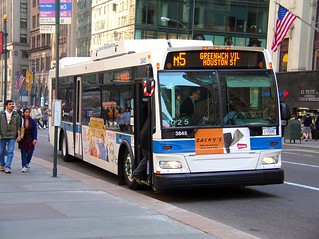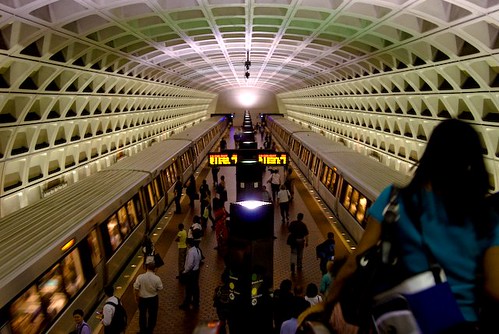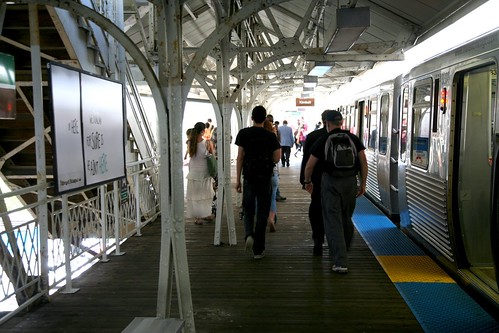America's best cities for public transportation

Posted April 26, 2012 at 1:30PM
Which are the best US cities for those who need or prefer to use public transportation? New York, San Francisco, Boston, Washington, and Philadelphia – in that order – according to the terrific organization Walk Score, whose range of services offered to the public just keeps getting better and better.
Today, Walk Score is releasing its first ranking of city transit systems, revealing which, by their calculations, offer residents the best access to public transportation. The rankings are based on the organization’s Transit Score, a GIS-based set of calculations that is a companion service to the organization’s flagship walkability rankings. Transit Score, according to the organization in a press release, “measures how well a location is served by public transportation, and is based on data released in a standard open format by public transit agencies.”
Here are the top 25 cities, listed with the Transit Score for each:
(1) New York (Transit Score: 81)
(2) San Francisco (Transit Score: 80)
(3) Boston (Transit Score: 74)
(4) Washington, DC (Transit Score: 69)
(5) Philadelphia (Transit Score: 68)
(6) Chicago (Transit Score: 65)
(7) Seattle (Transit Score: 59)
(8) Miami (Transit Score: 57)
(9) Baltimore (Transit Score: 57)
(10) Portland (Transit Score: 50)
(11) Los Angeles (Transit Score: 49)
(12) Milwaukee (Transit Score: 49)
(13) Denver (Transit Score: 47)
(14) Cleveland (Transit Score: 45)
(15) San Jose (Transit Score; 40)
(16) Dallas (Transit Score: 39)
(17) Houston (Transit Score: 36)
(18) San Diego (Transit Score: 36)
(19) San Antonio (Transit Score: 35)
(20) Kansas City (Transit Score: 34)
(21) Austin (Transit Score: 33)
(22) Sacramento (Transit Score: 32)
(23) Las Vegas (Transit Score: 32)
(24) Columbus (Transit Score: 29)
(25) Raleigh (Transit Score: 23)
 Note the very wide range. Only ten cities score 50 or above, which may partially explain why Americans use public transportation less than citizens of almost every other country.
Note the very wide range. Only ten cities score 50 or above, which may partially explain why Americans use public transportation less than citizens of almost every other country.
In calculating a Transit Score for a particular location, a "usefulness" value is assigned to nearby transit routes based on frequency of service, type of route, and distance to the nearest stop on the route. City scores are then calculated by applying the Transit Score algorithm block-by-block throughout the city and weighting the scores by population density. Walk Score’s web site contains a detailed description of the methodology used in the transit ratings.
I’ve been following the evolution of Walk Score’s services from the beginning, and I am continually impressed not just by the services they offer but by the continual improvement the staff puts into them.
There is little question that, with rising fuel prices and shifts in consumer preferences, demand for convenient access to public transit is growing. This seems particularly true for the Millennial generation (those born roughly between 1980 and 2000), which is driving significantly less than their predecessors. According to a study conducted by The Frontier Group, a research and policy analysis firm, for the USPIRG Education Fund and released earlier this month,  the average annual number of vehicle miles traveled by young people decreased from 10,300 miles to 7,900 miles per capita--a drop of 23 percent--from 2001 to 2009. Overall, the average American was driving 6 percent fewer miles per year in 2011 than in 2004.
the average annual number of vehicle miles traveled by young people decreased from 10,300 miles to 7,900 miles per capita--a drop of 23 percent--from 2001 to 2009. Overall, the average American was driving 6 percent fewer miles per year in 2011 than in 2004.
Meanwhile, according to the same report, the average annual number of miles traveled by 16 to 34 year olds on public transit, such as trains and buses, increased by 40 percent during that period. The American Public Transportation Association reports that Americans took 10.4 billion trips on public transportation in 2011, and that riding public transportation saves individuals an average of over $10,000 per year.
Related posts:
- Madness: the NCAA Sweet Sixteen decided by Walk Score! (March 20, 2012)
- New data show how transit corridors reduce traffic, increase walking (August 17, 2011)
- Households in transit-oriented locations save more energy and emissions than even 'green' households in sprawl (February 24, 2011)
- Use it (transit) to lose it (weight) (August 17, 2010)
- Poll finds overwhelming US support for improved public transportation – slideshow summary (April 7, 2010)
Move your cursor over the images for credit information.

